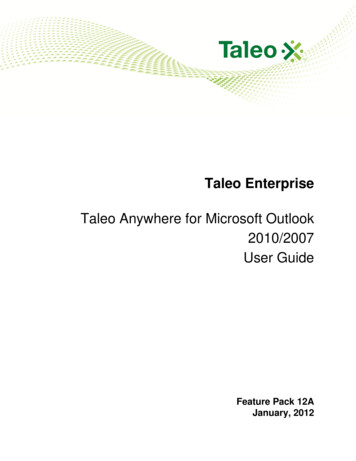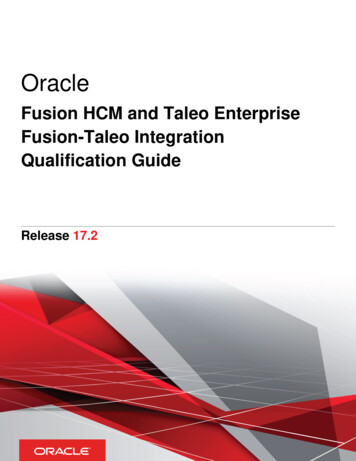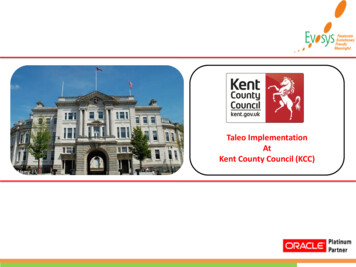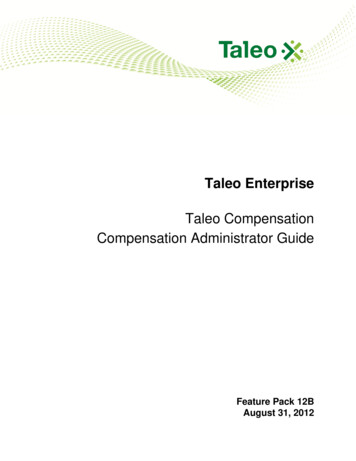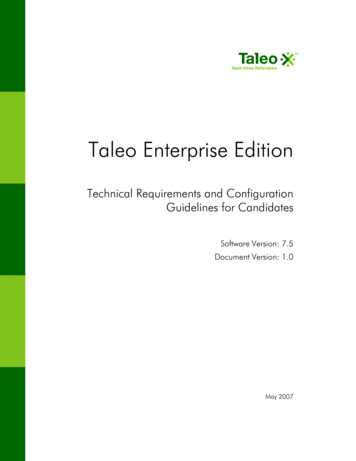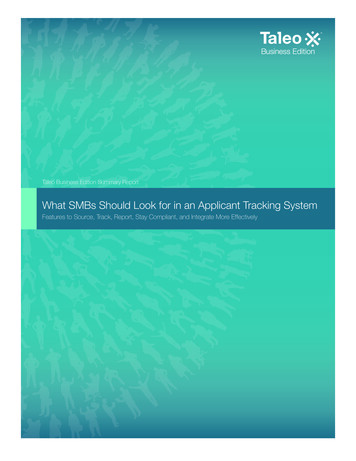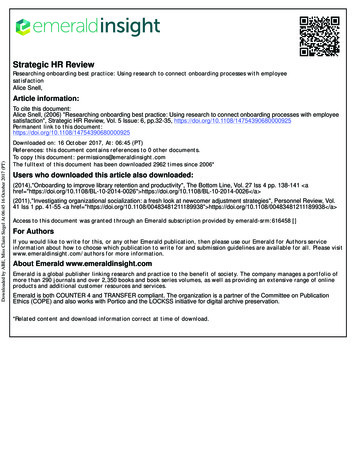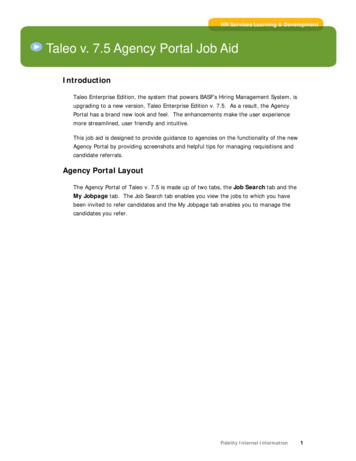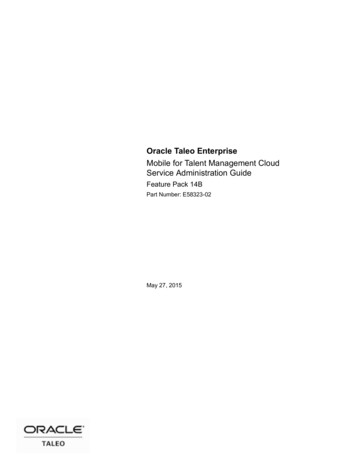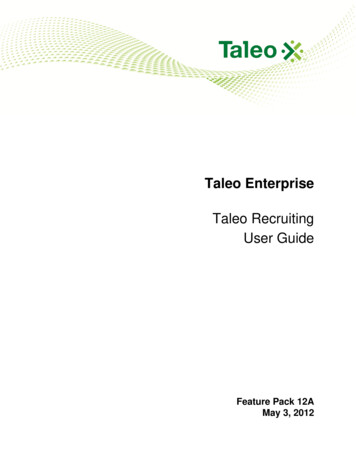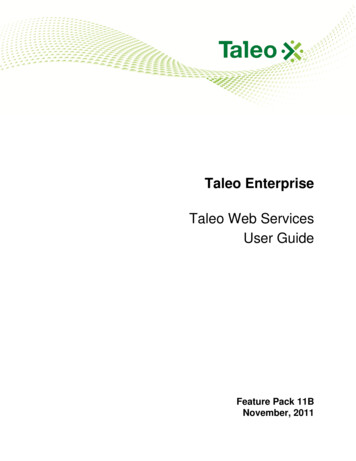
Transcription
Taleo EnterpriseTaleo Web ServicesUser GuideFeature Pack 11BNovember, 2011
Confidential Information and NoticesConfidential InformationThe recipient of this document (hereafter referred to as "the recipient") agrees that the ConfidentialInformation disclosed herein by Taleo shall be retained in confidence by the recipient, and itsrespective employees, affiliates and/or subsidiaries.For the purpose herein, the term "Confidential Information" shall mean the following:1. Any information, know-how, data, process, technique, design, drawing, program, formula or testdata, work in process, business plan, sales, suppliers, customer, employee, investor or businessinformation contained in a document, whether in written, graphic, or electronic form; or2. Any document, diagram, or drawing which is either conspicuously marked as "Confidential", knownor reasonably known by the other party to be confidential, or is of a proprietary nature, and islearned or disclosed in the course of discussions, demonstrations, or other collaboration undertakenbetween the parties.Limited Rights Notice (Dec 2007)1. These data are submitted with limited rights under Subcontract No. 6896589. These data maybe reproduced and used by the Government with the express limitation that they will not, withoutwritten permission of the Contractor, be used for purposes of manufacture nor disclosed outsidethe Government; except that the Government may disclose these data outside the Governmentfor the following purposes, if any; provided that the Government makes such disclosure subject toprohibition against further use and disclosure: None.2. This notice shall be marked on any reproduction of these data, in whole or in part. 2011 Taleo Corporation. Do not reproduce without the written permission of Taleo Corporation.User GuideWeb Services 11Bii
Table of ContentsConfidential Information and Notices. iiGetting StartedThe Taleo API. 2Quick Start. 8Standard Type Basics. 11API Call Basics.33Security and the API. 35API ReferenceData Model. 40Selection Query Language.41Bulk APIOverview. 43Message Processing. 46Error Handling.48Management Service.52Mapping Feature.73Import Feature. 76Export Feature. 81AppendixWeb Service Limits.86Version 7.5 Namespace Limitations.88Export Query Performance Throttles. 91Web Services Client Sample Code.92User GuideWeb Services 11Biii
User GuideWeb Services 11Biv
Getting Started The Taleo API.2Quick Start. 8Standard Type Basics.11API Call Basics. 33Security and the API.35
Getting StartedThe Taleo APIThe Taleo APITaleo provides programming access to your organization's information using a simple, powerful, andsecure application programming interface, the Taleo Web Service API (the API).To use this document, you should have a basic familiarity with software development, Web services,and the Taleo user interface. Knowledge of the Taleo Connect Client is not required, but would greatlyhelp to understand and visualize the Data Model made available through the Taleo API.The API consists of a set of callable methods, and some API endpoints. Its documentation is divided intwo parts: The first part (this document) describes the purposes of the API, its Standard Compliance, and howto use it using common Development Platforms. It further describes basics about Web servicesCalls and Standard Taleo Data Types, and covers Error Handling, Security and Limits applying toany Web service of the API.The second part consists of several documents, referred to as Taleo data dictionaries. Each datadictionary applies to one specific Taleo product and lists a set of callable methods specificallymade available for that Product. A data dictionary further describes the Data Model applying to theassociated Product, making reference to its Entities, Fields and Relations.Integrate And Extend Taleo SolutionsSpeed and agility are the keys to success in the highly competitive market for top talent. Integrationbetween your talent management solution and your extended network of service providers is critical forstreamlined processes and high quality hires.The Taleo API allows you to integrate and extend Taleo Solutions using the language and platform ofyour choice: Integrate Taleo with your organization: The Taleo API enables seamless transfer between TaleoEnterprise Edition, data warehouses, backend human resources information system (HRIS), andfinancial systems such as Oracle, PeopleSoft, JD Edwards, SAP, Lawson, and others.Extend Taleo Solutions: The Taleo API helps you to extend your talent management processes toexternal partners, eliminating manual steps in your process, costly process delays and errors, andthe headaches of typical integration projects.For more information about Taleo Solutions, visit http://www.taleo.com/solutions or contact yourcustomer representative.Standard ComplianceThe API is implemented to comply with the following specifications:Standard NameWebsiteSimple Object Access Protocol (SOAP) 1.1http://www.w3.org/TR/2000/NOTE-SOAP-20000508Web Service Description Language (WSDL) ertext Transfer Protocol (HTTP) lWS-I Basic Profile 004-04-16.htmlUser GuideWeb Services 11B2
Getting StartedThe Taleo APIStandard NameWebsiteWeb Services Security -Security SAML Token Profile 1.1 rity Username Token Profile 1.1 re are many different styles of SOAP messages; the two most common today are rpc/encodedand document/literal. The Taleo API only supports the document/literal style, as rpc/encoded style isnot endorsed by WS-I Basic Profile 1.1 and was removed in the SOAP 1.2 specifications. Technically,using the document/literal style means that a SOAP Body of a Web service request will be a complexmessage document that must conform to a specific XML schema (included in the WSDL of the Webservice).Development PlatformsThe API has already been successfully tested against the following Development Platforms:Development PlatformWebsiteAXIS2 v1.3 using XmlBeans and ADB Data Bindinghttp://ws.apache.org/axis2/C# using .NET Framework 3.0 efault.aspxXFire 1.2.6 using XmlBeans Data Bindinghttp://xfire.codehaus.org/If your Platform is not listed above, this means it has not yet been tested. Assuming this one iscompliant with our supported Standard Compliance, you should be able to access and use the APIsuccessfully.API Support PolicyTaleo recommends that your new client applications use the most recent version of the WSDL file tofully exploit the benefits of richer features and greater efficiency. When a new version is released, usethe following steps in the Quick Start to update your WSDL: Regenerate the WSDL file (see Step 3: Generate or Obtain the Web Services WSDL FilesImport it into your environment (see Step 4: Import the WSDL File Into Your Development PlatformBackward CompatibilityTaleo strives to make backward compatibility easy when using its API. Each Taleo product isassociated to a data dictionary, defining its product specific API. Each data dictionary is bound to aspecific mapping version. Backward compatibility support differs between minor versions (i.e. 7.5 SP1,7.5 SP2) and major versions (7.0, 7.5, 8.0).We maintain support for each minor version of a product. We also maintain support for the last majorversion preceding the current version. The API is backward compatible in that an application createdUser GuideWeb Services 11B3
Getting StartedThe Taleo APIto work with a given data dictionary mapping version will work with that same mapping version in futureminor versions and the next future major version of the product.Taleo does not guarantee that an application written against one API version will work with future APIversions: Changes in method signatures and data representations are often required as we continue toenhance the API. However, we strive to keep the API consistent from version to version with minimal, ifany changes, required to port applications to newer API versions.For example, an application written using the Taleo Professional 7.5 API shipped with the TaleoEnterprise Edition 7.5 release will continue to work with all future minor versions (i.e. Taleo EnterpriseEdition 7.5 SP1), and with the next major version of the product (i.e. Taleo Enterprise Edition 8.0),using that same API. However, the same application may not work with later versions of the product(i.e. Taleo Enterprise Edition 8.5) without modifications to the application, using the latest availableproduct API (i.e. Taleo Professional 8.5 API).API End of LifeTaleo is committed to supporting each API version for a minimum of two (2) major versions fromthe version of first release. In order to mature and improve the quality and performance of the API,versions that were introduced more than one major version before the current version may cease to besupported.For example, in the figure above, a major version is released, with a given version 1 of a servicelayer (Web Service API). A new major version is released, and the service layer also releases a newversion. The former version is now supported, but deprecated. Then, a new major version is released,but no new service layer version is released. Support for version 1 of the service layer ends, and nowonly one version is supported. Then, a new major version is released, with a new service layer version.The version 2 is still supported, but deprecated.Taleo Web Services NamespacesVarious namespaces are used inside a Taleo Web Service WSDL and SOAP document. Thesenamespaces define specific parts of the document and are also used for versioning purposes. TaleoWeb Services can be defined into two categories of services: import and export services.Taleo 10 NamespacesUser GuideWeb Services 11B4
Getting StartedThe Taleo egration/toolkit/[version]The integration toolkit namespace.This namespace is used to define elements related tothe integration toolkit framework.The integration toolkit framework is where the Taleocomponent web service infrastructure resides.It is used in the definition of elements such as tNickname][nsVersion]/ The service namespace.[service]This namespace is used to define elements related tothe web service itself.It is used in the definition of elements such theoperation parameters data types. It is the link betweenthe service and the Taleo data model.Its name is composed of the product nickname (i.e.:tee for Taleo Enterprise, so for Smartorg, etc.) followedby the namespace version (i.e. 2009/01) and theservice name (i.e. for the DepartmentService, it will bedepartment).Example:WebService: [productNickname][nsVersion]/ The product import data model.importThis namespace is used to define elements relatedto the integration data model used to define all theentities that can be used in import services. It is usedin the definition of elements such as the User, theCandidate, the Requisition and all the other Taleoentities.Its name is composed of the product nickname (i.e.:tee for Taleo Enterprise, so for Smartorg, etc.) followedby the namespace version (i.e. 2009/01) and theimport ctNickname][nsVersion]The product export data model.This namespace is used to define elements relatedto the integration data model used to define all theentities that can be used in export services.User GuideWeb Services 11B5
Getting StartedThe Taleo APINamespaceDescriptionIt is used in the definition of elements such as theUser, the Candidate, the Requisition and all the otherTaleo entities.Its name is composed of the product nickname (i.e.:tee for Taleo Enterprise, so for Smartorg, etc.) followedby the namespace version (i.e. 2009/01). For technicalreasons, this namespace is not ended by the exportstring (as opposed to the import 800/2009/01Version 7.5 /ws/integration/toolkit/[version]The integration toolkit namespace.This namespace is used to define elements related tothe integration toolkit framework.This is the Taleo component where the web serviceinfrastructure resides.It is used in the definition of elements such as tNickname][nsVersion] The product import and export data model.This namespace is used to define elements related tothe integration data model used to define all the entitiesthat can be used in import and export services.It is used in the definition of elements such as the User,the Candidate, the Requisition and all the other Taleoentities.Its name is composed of the product nickname (i.e.: artfor Active Recruiting Technology, so for Smartorg, etc.)followed by the namespace version (i.e. /art750/2006/12Namespace LimitationsThe namespace strategy has evolved between Taleo 7.5 and Taleo 10 versions. The 7.5 version ismissing some concepts to really make each piece of information independent of each other. This willbe described in greater detailed in the Taleo 7.5 Namespaces section.User GuideWeb Services 11B6
Getting StartedThe Taleo APIUsing Web ServicesFor each specific Taleo product, a list of WSDL files is available. Any number of commercial oropen source tools can then be used to create clients that access these services. The soapUI project(www.soapui.org) offers a free open source no-frills yet complete user interface to create and test webservice calls. Other commercial solutions offer more advanced features: XML Spy (www.altova.com),Stylus Studio (www.stylusstudio.com) and oXygen (www.oxygenxml.com). In order to embed webservice calls within an application, the Apache Web Service Axis2 project (ws.apache.org/axis2) offersa WSDL2Java tool that generates the proper source code for a Java based project. Microsoft .NETalso offers a web service toolkit for its development framework. The Quick Start section provides a stepby step procedure using these toolkits.Multiple books and articles are available that describe in detail how to interact with the web services,SOAP, and WSDL standards. Some interesting starting points are: http://www.w3.org/2002/ws (standards and links)http://www.webservices.org (Vendor-neutral Web Services industry portal)http://java.sun.com/webservices (Sun's Java web services portal)http://msdn.microsoft.com/webservices (Microsoft's .NET web services portal)Using SOAP UI with Taleo WSDLThere are constraints that SOAP UI users must be aware of when using Taleo WSDL to generate atest suite and/or a test request.When creating a new WSDL project and adding a Taleo WSDL, DO NOT "Create default requests forall operations".When creating a new test request, DO NOT "Create optional elements in schema."Many Taleo operations use entity type parameters that are composed of base type entities. Thesebase type entities can be specialized, and sometimes must be, to pass the correct data. To correctlysupport that characteristic, each base type in the WSDL is composed of a list of elements from allits specialized types. For detailed information about how to work with base types, refer to sectionOperations On Parameters With Base Type Elements.User GuideWeb Services 11B7
Getting StartedQuick StartQuick StartYou will need a User Account with "Web Service" permissions to be able to access and use the TaleoAPI. If you do not have such an account, contact your System Administrator to request one.The following steps will create a sample application in your development environment:Step 1: Have the Taleo Production Team Enable the Web Service FrameworkBy default, the web service framework is disabled. The Taleo Production Team will activate it for youupon a proof of purchase. Contact your Customer Representative for further details about pricing andactivation.Step 2: Obtain and Activate a Taleo User Account with Web Services PermissionsTo access the Taleo API you need to have a Taleo User Account activated with Web ServicePermissions. While developing, staging, and testing your application, we strongly recommend touse a dedicated testing or staging application to test your application against sample data instead ofyour organization's live data. This is especially true for applications that will be inserting, updating, ordeleting data (as opposed to simply reading data). Your System Administrator will provide you with alogin username and password for your product environment.Step 3: Generate or Obtain the Web Services WSDL FilesTo access the Taleo API, you need the Web Service Description Language (WSDL) filescorresponding to the Web Services. A WSDL file defines a Web service that is available to you. Yourdevelopment platform uses this WSDL to generate an API to access the Web service it defines. EachWeb service available through the Taleo product is defined by a dedicated WSDL file. You can eitherobtain the WSDL files from your Customer Representative or you can generate them yourself if youhave access to the WSDL download page in the Taleo product user interface. For more informationabout WSDL, see http://www.w3.org/TR/wsdlGenerating the WSDL File for Your OrganizationAny user with "Web Service" permission can download the Web Service Description Language(WSDL) file to integrate and extend Taleo using the API. Any user with the "System Integrator" role hasthis permission.The WSDL file is dynamically generated based on which Taleo product (i.e. Taleo Enterprise Edition- Professional) you download. The generated WSDL defines all API calls, objects (including standardand common objects), and fields that are available for API access for your organization.To generate the WSDL file for your organization: Log in to your account using the URL specified in the data dictionary corresponding to your Taleoproduct (i.e. for Taleo Professional, log in to https://hostname.taleo.net/servlets/soap). You must login as an administrator or as a user who has the "Web Service" permission.You should see a list of Web services available for this product. If the Web service you are lookingfor is not in the list, you may not have enough privileges to access it, you may be using the wrongURL for the Product, or you are searching for a deprecated Web service that has been removed orreplaced by another one since the last major version.Right-click the Web service name to display your browser's save options, and save the WSDL to alocal directory.Note: If a new version of the data dictionary (Product API) is released, you will need to regenerate theWSDL file in order to access the newest call and type definitions.User GuideWeb Services 11B8
Getting StartedQuick StartStep 4: Import the WSDL Files Into Your Development PlatformOnce you have the WSDL file, you need to import it into your development platform so that yourdevelopment environment can generate the necessary objects for use in building client Web serviceapplications in that environment. This section provides sample instructions for Apache Axis andMicrosoft Visual Studio. For instructions about other development platforms, see your platform’sproduct documentation.Instructions for Java Environments (Apache Axis)Java environments access the API through Java objects that serve as proxies for their server-sidecounterparts. Before using the API, you must first generate these objects from your Web service'sWSDL file. If you are using more than one Web service in your application, you must generate theseobjects from each WSDL file.Each SOAP Java client has its own tool for this process. For Apache Axis2, use the WSDL2Java utility.Note: Before you run WSDL2Java, you must have Axis2 installed on your system.The basic syntax for WSDL2Java from the Axis2 InstallPath/bin is:wsdl2java.bat -uri pathToWsdl/WsdlFilename -d xmlbeans -ns2pnamespaceURL javaPackageNameThe -d specifies the Databinding framework; here xmlbeans (http://xmlbeans.apache.org) is used. The-ns2p specifies a comma separated list of namespaces and packages where the given package willbe used in the place of the auto generated package for the relevant namespace. For more information,see the WSDL2Java documentation.Taleo strongly recommends to always specify a different target package name for each WSDL file(or Web service) because different WSDL files may refer to the same data type name although usingdifferent data type definition. Specifying different Java package names will prevent Java class namecollisions when more than one Taleo Web service is used within the same application.For example, if the Axis JAR files are installed in C:\axis2-1 3, and the WSDL is namedCandidateService.wsdl and is stored in C:\mywsdls, and you want to map the Webservice mapping version http://www.taleo.com/ws/art750/2006/12 to a specificcom.taleo.art750.candidate package, you would invoke:C:\axis2-1.3\bin\wsdl2java.bat -uri C:\mywsdls\CandidateService.wsdl -d xmlbeans -ns2p http://www.taleo.com/ws/art750/2006/12 /integration/toolkit/2005/07 com.taleo.itkThis command will generate a set of folders and Java source code files in the same directory in whichit was run. After these files are compiled, they can be included in your Java programs for use increating client applications.For most Java development environments, you can use wizard-based tools for this process instead ofthe command line. For more information about using WSDL2Java, see uctions for Microsoft Visual StudioVisual Studio languages access the API through objects that serve as proxies for their server-sidecounterparts. Before using the API, you must first generate these objects from your Web service'sWSDL file. If you are using more than one Web service in your application, you must generate theseobjects from each WSDL file.Visual Studio provides two approaches for importing a WSDL file and generating an XML Web serviceclient: an IDE-based approach and a command line approach.User GuideWeb Services 11B9
Getting StartedQuick StartNote: Before you begin, you must create a new application or open an existing application in VisualStudio. In addition, you need to have generated the WSDL file(s), as described in Step 3: Generate orObtain the Web Services WSDL Files.A Visual Studio XML Web service client is any component or application that references and uses anXML Web service. This does not necessarily need to be a client-based application. In fact, in manycases, your XML Web service clients might be other Web applications, such as Web Forms or evenother XML Web services. When accessing XML Web services in managed code, a proxy class andthe .NET Framework handle all of the infrastructure coding.To access an XML Web service from managed code:1. Add a Web reference to your project for the XML Web service that you want to access. The Webreference creates a proxy class with methods that serve as proxies for each exposed method of theXML Web service.2. Add the namespace for the Web reference.3. Create an instance of the proxy class and then access the methods of that class as you would themethods of any other class.To add a Web reference:1. On the Project menu, choose Add Web Reference.2. In the URL box of the Add Web Reference dialog box, type the URL to obtain theservice description of the XML Web service you want to access, such as: file:///c:\WSDLFiles\CandidateService.wsdl or https://hostname/servlets/soap?ServiceName CandidateService&wsdl.3. Click Go to retrieve information about the XML Web service.4. In the Web reference name box, rename the Web reference, such as taleo.candidatesvc, which isthe namespace you will use for this Web reference.5. Click Add Reference to add a Web reference for the target XML Web service. For more information,see the topic "Adding and Removing Web References" in the Visual Studio documentation.6. Visual Studio retrieves the service description and generates a proxy class to interface betweenyour application and the XML Web service.To import other Web services in your application, follow the same procedure described above for eachWSDL file.For a walk through of sample code that uses the WSDL generated stub, refer to the AppendixWebServices Client Sample Code section.User GuideWeb Services 11B10
Getting StartedStandard Type BasicsStandard Type BasicsGenerally speaking, a data dictionary is the complete reference for the data model and services ofa given Taleo Product. The data model consists of entities with fields and relations between otherentities. Entities represent the information stored in the application. The services expose callablemethods that allow you to access the data model entities from a client application.To allow you to query, add, update, or delete data, all entity fields and relations are mapped into Taleospecific datatypes, hereafter called Standard Types.The API exposes two categories of services: export and import services. Taleo products expose onesingle export service, called FindService: this one uses Export Standard Types to allow you toquery data. All other services use Import Standard Types to allow you to add, edit, or delete data. Asopposed to the export service, which is available for all products, import services are specific to eachproduct: Please refer to the data dictionary of each Taleo product for an exhaustive list of its availableWeb services.Import Standard TypesThe following sections describes the standard types used by Web services that can add, edit, or deletedata, as opposed to the Export service that can only query data.The first section describes the mapping between Entity fields, as described in the Taleo product datadictionary and the Standard Types used by the API.The next sections describe each of these standard types, providing usage samples using XML (SOAPmessages), Java, and C# samples. These samples refer to the Taleo Enterprise Edition, Professional7.5 data dictionary. The code snippets presented here are partial only, and aim to demonstrate theusage of each standard type. For a complete code sample in Java or C# involving an import request,refer to the Quick Start sectionEntity Fields Definition vs. Import Standard Types MappingEach Entity Field is defined in the data dictionary (Field Details section) with the following importrelevant attributes: Create: The field can be set when not yet already set.Update: The field can be updated when already set.Search: The field can be set or updated using a lookup query (specifying a search value).Multilingual: The field can be set to multiple value, one per language.The API considers all field values as String, no matter the type spe
Enterprise Edition 7.5 release will continue to work with all future minor versions (i.e. Taleo Enterprise Edition 7.5 SP1), and with the next major version of the product (i.e. Taleo Enterprise Edition 8.0), using that same API. However, the same application may not work with later versions of the product (i.e. Taleo Enterprise Edition 8.5 .
